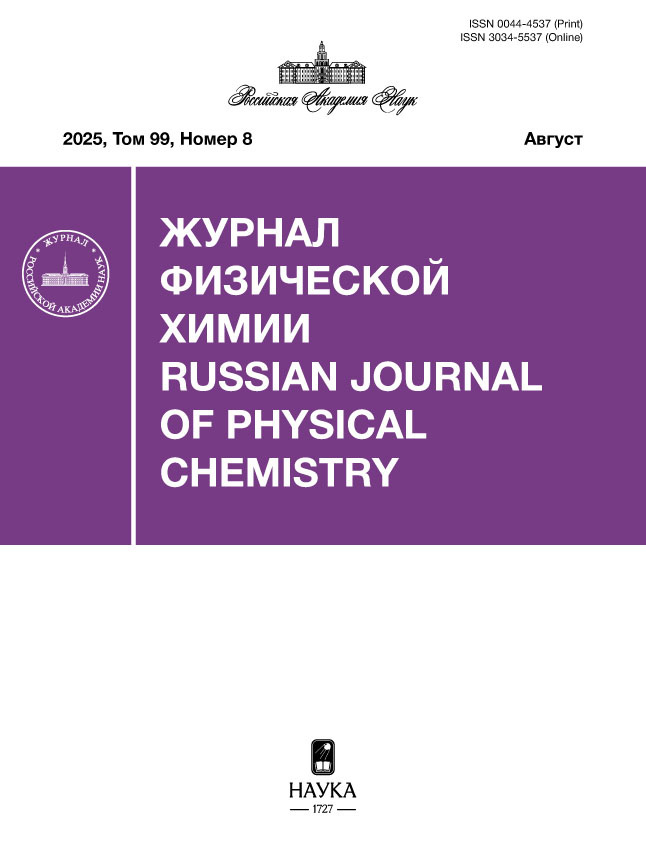Formation of dense Ti-B-Fe system product obtained by self-propagating high-temperature synthesis
- Authors: Lepakovа O.K.1, Shkoda O.A.1, Braverman B.S.1
-
Affiliations:
- Tomsk Scientific Center of the Siberian Branch of the Russian Academy of Sciences
- Issue: Vol 99, No 3 (2025)
- Pages: 477–483
- Section: ФИЗИЧЕСКАЯ ХИМИЯ ПРОЦЕССОВ ГОРЕНИЯ И ВЗРЫВА
- Submitted: 03.06.2025
- Published: 29.05.2025
- URL: https://modernonco.orscience.ru/0044-4537/article/view/682035
- DOI: https://doi.org/10.31857/S0044453725030136
- EDN: https://elibrary.ru/ECQWPK
- ID: 682035
Cite item
Abstract
The possibility of obtaining a dense material of the Ti-B-Fe system in one stage during self-propagating high-temperature synthesis is studied. The influence of some process parameters on the densification of reaction products of the Ti-B-Fe system, which has high physical and mechanical characteristics, is studied. The maximum temperature developed in the combustion wave, using ferroboron alloys as initial reagents, annealing of initial powders, and preheating of the charge before self-propagating high-temperature synthesis are established to have the greatest influence on the formation of a nonporous product during the combustion of the Ti-B-Fe system.
Full Text
About the authors
O. K. Lepakovа
Tomsk Scientific Center of the Siberian Branch of the Russian Academy of Sciences
Email: O.Shkoda@dsm.tsc.ru
Russian Federation, Tomsk
O. A. Shkoda
Tomsk Scientific Center of the Siberian Branch of the Russian Academy of Sciences
Author for correspondence.
Email: O.Shkoda@dsm.tsc.ru
Russian Federation, Tomsk
B. Sh. Braverman
Tomsk Scientific Center of the Siberian Branch of the Russian Academy of Sciences
Email: O.Shkoda@dsm.tsc.ru
Russian Federation, Tomsk
References
- Гольдшмидт Х. Дж. Сплавы внедрения. Вып. 1. М.: Мир, 1971. 423 с.
- Серебрякова Т.И., Неронов В.А., Пешев П.Д. Высокотемпературные бориды. М.: Металлургия, 1991. 367 с.
- Cамсонов Г.В., Марковский Л.Я., Жигач А.Ф. и др. Бор, его соединения и сплавы. Киев: Изд-во Академии наук УССР, 1960. 590 с.
- Киффер Р., Бенезовский Ф. Твердые материалы. М.: Металлургия, 1968. 384 с.
- Merzhanov A.G., Rogachev A.S. // Pure and Appl. Chem. 1990. V. 64. P. 941. http://dx.doi.org/10.1351/pac199264070941
- Свойства, получение и применение тугоплавких соединений / Под ред. Т.Я. Косолаповой. М.: Металлургия, 1986. 928 с.
- Baumgartner H.R., Steiger R.A. // J. Amer. Ceram. Soc. 1984. V. 67. № 3. P. 207. https://doi.org/10.1111/j.1151-2916.1984.tb19744.x
- Hyjek P., Sulima I., Jaworska L. // Mater Trans A. 2019. V. 50. P. 3724. https://doi.org/10.1007/s11661-019-05306-w
- Yujiao K., Kazuhiro M., Zhefeng X., et al. // Mater Trans Volume. 2019. V. 60. № 12. https://doi.org/10.2320/matertrans.MT-M2019168
- Yangyang Sun, Hui Chang, Zhigang Fang, et al. // MATEC Web of Conferences. 2020. V. 321. P. 11029. https://doi.org/10.1051/matecconf/202032111029
- Kumar R., Liu L., Antonov M., et al. // Materials. 2021. V. 14. P. 1242. https://doi.org/10.3390/ma14051242
- Khanra A.K., Godkhindi M.M., Pathak L.C. // Mater Sci Eng A. 2007. V. 454–455. P. 281. https://doi.org/10.1016/j.msea.2006.11.083
- Диаграммы состояния двойных и многокомпонентных систем на основе железа. Справочник / Под ред. О.А. Банных, М.Е. Дрица. М.: Металлургия, 1986. 439 с.
- Лактионов В.А., Панарин В.Е., Тихонович В.И. и др. // Проблемы трения и изнашивания. 1974. № 5. С. 15.
- Орданьян С.С. // Огнеупоры. 1992. № 9/10. С. 10.
- Юридицкий Б.Ю., Песин В.А, Орданьян С.С. // Порошковая металлургия. 1982. № 4. С. 32.
- Merzhanov A.G., Rogachev A.S., Mukas’yan A.S., et al. // Combust Explos Shock Waves. 1990. V. 26. P. 92. https://doi.org/10.1007/BF00742281
- Bogatov Y.V., Shcherbakov V.A. // Int. J. Self-Propag. High-Temp. Synth. 2023. V. 32. P. 239. https://doi.org/10.3103/S1061386223030032
- Bogatov Y.V., Shcherbakov V.A. // Russ. J. Non-ferrous Metals. 2021. V. 62. P. 248. https://doi.org/10.3103/S1067821221020036
- Bogatov Y.V., Shcherbakov V.A. // Int. J. Self-Propag. High-Temp. Synth. 2020. V. 29. P. 100. https://doi.org/10.3103/S106138622002003X
- Lark A., Du J., Chandran K. // J. Mater. Res. 2018. V. 33. P. 4296. https://doi.org/10.1557/jmr.2018.368
- Lepakova O.K., Raskolenko L.G., Maksimov Y.M. // Combust Explos Shock Waves. 2020. V. 36. P. 575. https://doi.org/10.1007/BF02699520
- Bazhin P., Konstantinov A., Chizhikov A., et al. // Mater. Today Commun. 2020. V. 25. P. 101484. https://doi.org/10.1016/j.mtcomm.2020.101484.
- Springer H., Fernandez R., Duarte M., et al. // Acta Mater. 2015. V. 96. P. 47. 10.1016/J.ACTAMAT.2015.06.017' target='_blank'>http://doi: 10.1016/J.ACTAMAT.2015.06.017
- Башле Э., Лезу Ж. Качество отливок из жаропрочных сплавов / В кн.: Жаропрочные сплавы для газовых турбин. М.: Металлургия, 1981. С. 342.
Supplementary files
















